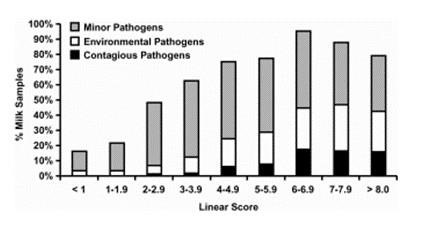By Greg Strait
One main goal of all dairy farms is to produce high quality, fresh, clean milk. There are many management factors that go into producing this wholesome product. A healthy, well-cared for dairy animal is a top priority to achieve this goal. Nutrition, cow comfort, water availability, and a well-maintained milking system are just a few pieces of the puzzle in producing high quality milk. One key factor is cleanliness; a clean parlor, equipment, environment, and especially clean cows all contribute to the production of high-quality milk on dairy farms.
Mastitis can lead to a decrease in the quality of milk being produced, as well as a decline in the overall health of the animal. Mastitis is the increase in white blood cells in the mammary tissues of a dairy cow. This increase in cells is then reflected in the somatic cell count (SCC) of milk produced. There are many ways to combat mastitis incidences in cows, with prevention being one of the most important management practices on a dairy farm. A study published in the Journal of Dairy Science focusing on the relationship between udder and leg hygiene scores found a significant association between contagious pathogens and udder hygiene (Schreiner and Ruegg, 2003). The graph provided illustrates this correlation between the prevalence of pathogens and the cleanliness of udders shown with linear scores. The higher the score, the dirtier the udder.

Farmers and producers can minimize these pathogens in milk by keeping udders as clean as possible. One way to achieve this is by removing the hair on the udders of the milking cows. This udder hair causes a problem in that it can become soiled. Bedding materials, manure, and other debris can get stuck to udder hair leading to problems such as mastitis and higher SCC. Research has shown that a clean udder, free of debris, will have a lower incidence of mastitis than those udders which are not clean and/or free of debris. If your cows are clean, the milk harvested will be of higher quality. Therefore, removal of udder hair can keep the cow cleaner, reduce mastitis, and improve quality of milk harvested. Hair may be removed from the udder in different ways, either clipping or singeing.
Using electric clippers will shorten udder hair, thus making the debris less likely to stick to the hair follicles. While clipping is effective, it takes a lot of time and patience. There is also noise associated with this method, and physically running clippers on the udder can make cows nervous increasing the risk of injury to the cow and the person clipping the udder.
Another way to shorten the hair is to singe the udder. This is a simple procedure that can have a significant positive impact on milk quality. Singeing off the hair is done with a cool 3-4" propane flame that is passed along the udder in a back and forth motion. Occasionally, the debris present on the udder can cause a flare up during the procedure so, persons doing the singeing should always wear a flame-resistant glove. This technique will take approximately 15 to 20 seconds per animal. The animal remains calm as there is no physical touching of the udder or the animal itself. There is considerably less noise and less trauma to the animal using singeing compared to clippers.
The removal of udder hair is just one step that can be done to help keep udders free from manure and debris that can harbor pathogens. Whether the udder hair is clipped or singed, proper management practices must be followed to ensure the safety of both the animal and the person removing the hair. When done correctly, clean udders are easier to prep for milking and along with other practices, can help to keep SCC numbers low and to produce high-quality milk.
Source : psu.edu